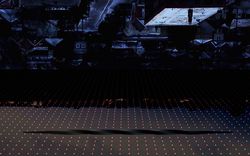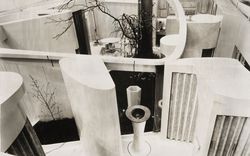2008: Survival 3000
Text by Damon Rich
Victor tried to save us before the disaster with his hybrid car. But we are caught by the water and abandon the car. We assemble in a building. We are afraid because the water is rising. We are on the roof and we are stuck there. Suddenly there is a boat from the Canadian Navy that rescues us and takes us to the CCA. The boat arrives by René-Lévesque Avenue. It strikes a building and made a hole in its hull. We need to jump into the lifeboats and paddle to the ground. People who look like survivors have already formed a team at the CCA. They help us reach a safe place.
At the CCA, all the people who want to live begin to rebuild their new houses. We have only tires, cardboard, wood, carpets, blankets, beds, pillows, and a few other things. Two days later, all the shelters are finished, but the water has torn down half of Montréal. Citizens agree to share duties for a new life in the year 3000. We build more houses, gardens, hospitals, construction workshops, farms, cemeteries, shops, etc.
—Inhabitants of the CCA, the year 3000
Because it can serve as a portal for intense interdisciplinary exploration, architecture has a crucial contribution to make to a reinvigorated civics curriculum. Arguably, such programs have been on the architectural agenda since Vitruvius, but today it takes more than a base, a shaft, and a capital to convey the makeup and dynamics of our society. Civics education must link the places in which we spend our everyday lives to the complex and abstract systems that shape them–economies, ecosystems, and polities.
An integrated architectural curriculum, where the history, debates, and methodologies of the discipline are used in teaching everything from math to writing to history, would serve some of the same purposes as existing architectural education for young people. But to justify its inclusion as an integrated subject instead of a compartmentalized one, architecture must not be taught as a specialized craft, but ought to be introduced as a social process. Starting from the fact that the Egyptian pyramids were built by slaves, students need to examine the power dynamics of building and property development.
Instead of memorizing styles, students would benefit far more from understanding why the buildings in their own neighborhoods look and function the way they do. Students should also be exposed to avant-garde visions, from the Walking City to Boullée’s Newton Cenotaph. A photomontage of a futuristic building is a great conversation-starter; however, dialogue must not stop at formal imagining, but must address how such proposals would shape the public realm and how they might be achieved.
Architecture’s educational potentials are not most threatened by philistine educators or vanishing budgets, but by design culture itself. If we believe that politics sometimes ruins good design, we undercut architecture’s role as a meditor between social values and built form, an inherently political process. If we insist too firmly on the division between « architecture » and « building », we discount broad access to the joys of the physical environment. Practitioners who grasp this disconnect between the civic realm and the professional high road will take every opportunity to energize, not dampen, the public’s imagination.
Encouraging all people to contribute to the making of our physical surroundings is a critical component of a free society. Granting a say to the widest population remains a political challenge: despite the decentralization of planning authority that swept the country in the 1960s, most people don’t play an active role in shaping their physical environment. Designing democratically does not mean that everyone goes to architecture school, but it could mean that architecture goes to everyone’s school.
Survival 3000 was our first Day Camp. It was developed in conjunction with the exhibition 1973: Sorry, Out of Gas (2007) and in collaboration with guest curator Damon Rich. For one week in November 2008, a group of eleven students from the high school École Accès Nord in the North of Montréal and our education team enacted a scenario set in the year 3000, following a global energy and climate crisis. Informed that their school and entire neighborhood were now submerged, the group set about building a new society, with new rules and new architecture. Everything was captured by the ever-present camera crew for the “reality show” they were told was being made about the adventure.

































